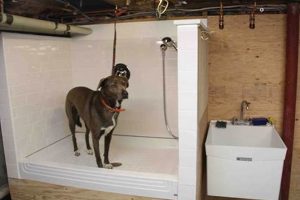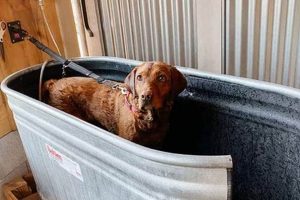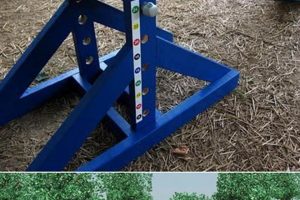Constructing a canine shelter involves selecting appropriate materials. Lumber serves as a primary component for creating durable and aesthetically pleasing enclosures for pets. The practice allows for customization of size and design to accommodate specific breed requirements and available space. For example, pressure-treated pine provides weather resistance, while cedar offers natural insect repellent properties.
The advantages of building a custom structure include cost savings compared to pre-fabricated options and the opportunity to tailor the kennel to precisely fit the dog’s needs and the owner’s aesthetic preferences. Historically, individuals have utilized available resources to provide shelter for animals, adapting construction techniques to local climates and materials. This approach ensures the well-being of the animal by providing a safe and comfortable environment.
Subsequent sections will detail the selection of suitable wood types, outline step-by-step building instructions, and address crucial safety considerations for creating a robust and secure enclosure. Detailed plans, tool requirements, and finishing options will also be presented to guide the construction process.
Essential Considerations for Canine Shelter Construction with Lumber
The following are crucial guidelines for building a safe and durable outdoor enclosure for dogs utilizing lumber as the primary building material. Adherence to these principles will ensure the longevity and safety of the structure.
Tip 1: Lumber Selection: Choose wood appropriate for outdoor use. Pressure-treated lumber resists rot and insect infestation, while cedar offers natural weather resistance and deters pests. Ensure the lumber is free from splinters and large knots that could compromise structural integrity.
Tip 2: Proper Fasteners: Use galvanized or stainless steel screws and nails designed for exterior applications. These fasteners resist corrosion, preventing structural weakening over time. Pre-drill holes to prevent splitting the wood, especially near edges.
Tip 3: Structural Integrity: Design the kennel with adequate support to withstand weather conditions. Incorporate cross bracing and secure corner joints to prevent racking. Consult local building codes to ensure compliance with wind and snow load requirements.
Tip 4: Ground Contact Prevention: Elevate the wooden structure slightly off the ground using concrete blocks or pressure-treated skids. This prevents moisture absorption and prolongs the life of the lumber. A gravel base underneath the kennel also aids in drainage.
Tip 5: Non-Toxic Finishes: When applying sealant or paint, select products specifically formulated for exterior use and safe for animal contact. Allow the finish to fully cure before allowing the dog access to the kennel to prevent ingestion of harmful chemicals.
Tip 6: Ventilation: Ensure adequate airflow within the kennel to prevent moisture buildup and overheating. Incorporate vents near the roofline and consider a partially open design to promote air circulation. Proper ventilation reduces the risk of respiratory problems and maintains a comfortable environment for the dog.
Tip 7: Routine Maintenance: Regularly inspect the wooden structure for signs of damage, such as rot, insect infestation, or loose fasteners. Promptly repair any issues to prevent further deterioration and maintain the structural integrity of the kennel. Apply a fresh coat of sealant or paint as needed to protect the wood from the elements.
Implementing these guidelines promotes the construction of a safe, durable, and comfortable outdoor kennel for canines, maximizing the longevity of the structure and ensuring the well-being of the animal.
The subsequent conclusion will summarize the core principles of construction and emphasize the importance of responsible material selection for a successful outcome.
1. Wood type
The selection of lumber significantly impacts the durability, safety, and longevity of a self-constructed canine shelter. The properties inherent to different wood species directly affect the kennel’s resistance to environmental factors, potential harm to the animal, and overall structural integrity.
- Weather Resistance
Different types of lumber exhibit varying degrees of resistance to moisture, sunlight, and temperature fluctuations. Pressure-treated lumber, for example, is chemically treated to resist rot and insect infestation, making it suitable for prolonged outdoor exposure. Cedar contains natural oils that repel insects and resist decay, while redwood offers similar benefits. The choice depends on the climate and exposure levels. In humid environments, moisture-resistant varieties are crucial to prevent premature degradation.
- Structural Strength
The load-bearing capacity of the lumber is a critical factor in kennel construction. Hardwoods, such as oak or maple, offer superior strength compared to softwoods like pine or fir. However, hardwoods are generally more expensive and difficult to work with. The size and breed of the dog, as well as the kennel’s design, dictate the required structural strength. Larger breeds or kennels with elevated platforms necessitate stronger lumber to ensure safety and prevent collapse.
- Animal Safety
Certain types of wood can be harmful to animals. Chemically treated lumber, while resistant to decay, may leach harmful substances that can be ingested or absorbed through the skin. Splintering is also a concern, as sharp wood fragments can cause injury. Smooth, untreated wood or wood finished with non-toxic sealant minimizes these risks. Selecting wood that is naturally safe for animal contact or properly sealed is crucial for protecting the dog’s health and well-being.
- Cost and Availability
The cost and local availability of different lumber types also influence the selection process. Pressure-treated pine is often readily available and relatively inexpensive, making it a common choice. However, more exotic or specialized woods may require sourcing from specialty lumberyards and can significantly increase the project’s overall cost. Balancing the desired properties with budget constraints is an essential consideration when planning a do-it-yourself kennel project.
Ultimately, selecting the appropriate lumber type involves a comprehensive assessment of environmental factors, structural requirements, animal safety considerations, and budgetary limitations. A well-informed decision results in a durable, safe, and cost-effective shelter for the canine companion.
2. Kennel size
The dimensions of a canine enclosure constructed from lumber are critical factors in ensuring the animal’s comfort, safety, and well-being. The size must be appropriately scaled to the dog’s breed, age, and physical characteristics to provide adequate space for movement and rest.
- Breed-Specific Requirements
Different breeds have varying spatial needs based on their size and activity level. A small breed, such as a Chihuahua, requires significantly less space than a large breed, such as a Great Dane. Kennel dimensions must accommodate the dog’s full adult size, allowing ample room to stand, turn around, and lie down comfortably. Failure to account for breed-specific requirements can lead to restricted movement, discomfort, and potential behavioral issues. For instance, a kennel intended for a Labrador Retriever should provide sufficient length and width for the dog to fully stretch out while lying down.
- Interior Configuration and Functionality
The kennel’s internal space should facilitate various activities beyond simple rest. A designated area for feeding and watering, protected from the elements, is essential. If the kennel is intended for use in colder climates, sufficient space for bedding is necessary to provide insulation and warmth. The interior layout should minimize obstructions and potential hazards, ensuring the dog can move freely and safely within the enclosure. For example, if a self-feeder is included, its placement should not impede the dog’s ability to move around the kennel.
- Growth Considerations
If the kennel is intended for a puppy, the dimensions must account for the dog’s anticipated growth. Constructing a kennel that accommodates the dog’s adult size prevents the need for subsequent modifications or replacements. While providing a smaller, separate sleeping area within the larger kennel may be beneficial for younger puppies, the overall dimensions should still be based on the anticipated adult size. This foresight ensures the kennel remains suitable throughout the dog’s life. Adjustable interior partitions can provide a means of adapting the available space to the dog’s changing needs.
- Building Material Constraints
The selected lumber’s dimensions and structural properties influence the overall kennel size. Standard lumber lengths may dictate the kennel’s width and length to minimize waste and simplify construction. Additionally, the lumber’s load-bearing capacity may limit the maximum dimensions of the kennel’s roof or walls. Balancing the desired kennel size with the available lumber options requires careful planning and potentially adjustments to the design. For instance, using longer lumber spans may necessitate thicker or stronger wood to prevent sagging or collapse.
Consideration of these factorsbreed-specific needs, functionality, growth, and lumber constraintsensures the constructed enclosure provides a safe, comfortable, and appropriate environment for the canine. The size must facilitate all the animal’s essential needs, adapting as necessary.
3. Joint strength
The structural integrity of a canine shelter constructed using lumber hinges critically on the strength of its joints. These junctures, where individual pieces of wood connect, bear the brunt of external forces, environmental stressors, and the dog’s own movements. The effectiveness of these connections directly impacts the kennel’s overall stability and longevity.
- Fastener Selection and Application
The type and application method of fasteners, such as screws, nails, and bolts, significantly contribute to joint strength. Galvanized or stainless steel fasteners are recommended for outdoor use to resist corrosion. The fastener’s length, diameter, and spacing must be appropriate for the lumber’s thickness and density. Pre-drilling pilot holes prevents wood splitting, ensuring a tighter and more secure hold. An example is using screws instead of nails in high-stress areas like corner joints, which provides superior pull-out resistance.
- Woodworking Techniques and Joinery Methods
Specific woodworking techniques, such as mortise and tenon, dovetail, and rabbet joints, enhance joint strength beyond simple butt joints. These methods create interlocking connections that resist pulling and shearing forces. While requiring more skill and time to execute, these advanced joinery methods provide superior structural integrity, particularly in larger kennels or those subject to significant stress. An example includes using mortise and tenon joints for framing members, which provides a strong and durable connection.
- Adhesive Utilization
Exterior-grade wood adhesives can augment joint strength by creating a continuous bond between lumber surfaces. These adhesives fill gaps, distribute stress, and prevent moisture penetration. Proper surface preparation, including cleaning and sanding, ensures optimal adhesion. Applying adhesive in conjunction with mechanical fasteners provides a synergistic effect, significantly increasing joint strength. An example is applying construction adhesive to the mating surfaces of a lap joint before fastening with screws.
- Design and Load Distribution
The overall design of the kennel influences the stress placed on individual joints. Distributing weight evenly and minimizing unsupported spans reduces the load on critical connections. Incorporating cross-bracing, gussets, and other structural elements strengthens the frame and prevents racking. A well-designed kennel distributes stress throughout the structure, reducing the risk of joint failure. An example includes using diagonal bracing to resist shear forces, preventing the kennel from collapsing under wind or snow loads.
In summary, achieving optimal joint strength in a lumber-constructed canine shelter requires careful consideration of fastener selection, woodworking techniques, adhesive utilization, and overall design. Neglecting any of these factors can compromise the kennel’s structural integrity and potentially endanger the animal. Proper jointing methods become paramount in regions prone to extreme weather conditions, such as high winds or heavy snowfall, further underlining their importance for overall kennel durability.
4. Weatherproofing
The longevity and functionality of a do-it-yourself canine shelter constructed from lumber are intrinsically linked to the effectiveness of weatherproofing measures. Lumber, an inherently porous material, is susceptible to degradation from moisture, temperature fluctuations, and ultraviolet radiation. Without adequate protection, the wood can rot, warp, crack, and become vulnerable to insect infestation, thereby compromising the kennel’s structural integrity and creating an unsafe environment for the animal. For instance, untreated pine exposed to repeated cycles of rain and sun will exhibit noticeable decay within a relatively short timeframe, necessitating costly repairs or complete reconstruction. Weatherproofing, therefore, becomes an indispensable component of any durable lumber-based kennel.
Effective weatherproofing involves a multi-faceted approach, encompassing material selection, protective coatings, and design considerations. Selecting naturally weather-resistant lumber species such as cedar or redwood provides a baseline level of protection. Applying exterior-grade sealants, paints, or stains creates a barrier against moisture penetration and UV damage. Proper drainage design, including elevating the kennel off the ground and incorporating roof overhangs, further minimizes exposure to the elements. Consider the example of a kennel constructed from pressure-treated lumber, sealed with a waterproof stain, and elevated on concrete blocks. This approach minimizes ground contact, prevents water absorption, and protects against sunlight degradation, significantly extending the kennel’s lifespan.
In conclusion, weatherproofing is not merely an optional add-on but a fundamental requirement for the successful construction of a lasting and safe canine shelter utilizing lumber. Neglecting proper weatherproofing techniques can lead to premature deterioration, structural failure, and potential harm to the animal. Prioritizing these measures translates to a more durable, cost-effective, and secure environment for the dog. Furthermore, understanding weatherproofing principles empowers individuals to make informed decisions about material selection, construction techniques, and maintenance practices, ultimately ensuring the long-term viability of their DIY project.
5. Safety hazards
Construction of a canine enclosure from lumber presents inherent safety hazards that necessitate careful consideration and proactive mitigation. The use of power tools, the potential for sharp edges and splinters, and the application of chemical treatments all pose risks to both the builder and the animal. Ignoring these potential dangers can lead to injury, illness, or structural failures. For example, improper handling of a power saw can result in lacerations, while the use of untreated lumber can expose the dog to harmful splinters. Therefore, an understanding of these hazards is paramount in ensuring a safe and successful do-it-yourself project.
Specific examples of safety concerns include the potential for toxic chemicals leaching from treated lumber, which can be addressed through the selection of appropriate materials and the application of non-toxic sealants. The presence of protruding nails or screws presents a risk of injury to the dog, and can be mitigated through careful construction techniques and regular inspection. Sharp edges on cut lumber can also pose a threat, and can be addressed through sanding and the application of edge banding. Furthermore, inadequate ventilation can lead to the accumulation of harmful gases within the kennel, which can be prevented through careful design considerations. Practical applications of this understanding include the use of personal protective equipment during construction, the selection of animal-safe materials, and the implementation of regular maintenance procedures.
In summary, addressing safety hazards is an indispensable aspect of constructing a canine shelter from lumber. Proactive identification and mitigation of potential dangers minimize the risk of injury or illness, ensuring a safe and functional enclosure for the animal. This requires a comprehensive approach, encompassing material selection, construction techniques, and ongoing maintenance. Failure to address these concerns can have significant consequences, potentially jeopardizing both the builder’s and the animal’s well-being. Prioritizing safety ensures a successful project outcome and a secure environment for the canine companion.
6. Design plan
A detailed plan serves as the foundational blueprint for any successful “diy dog kennel wood” project. It dictates material quantities, dimensions, structural integrity, and aesthetic considerations. Omission of a comprehensive design phase frequently results in structural instability, material waste, and inadequate accommodation for the canine occupant. A well-conceived plan, conversely, optimizes resource utilization and ensures adherence to safety standards. For instance, a plan lacking precise measurements can lead to mismatched lumber cuts, weakening joints and compromising the overall kennel structure. This deficiency can, in turn, necessitate costly rework or even project abandonment. Therefore, a robust design precedes any physical construction to mitigate potential errors and ensure the project’s viability.
The design plan integrates several crucial elements, including load-bearing calculations, ventilation strategies, and weatherproofing measures. Accurate load-bearing calculations, predicated on the selected lumber type and anticipated weight, prevent structural collapse under stress from snow, wind, or the dog itself. Adequately placed ventilation openings mitigate moisture buildup and prevent overheating, promoting the dog’s comfort and health. Incorporation of weatherproofing techniques, such as roof overhangs and elevated flooring, safeguards the lumber from water damage and extends the kennel’s lifespan. A design that fails to account for these elements creates a structure vulnerable to environmental degradation and unsuitable for canine habitation.
In conclusion, the design plan constitutes an indispensable prerequisite for the successful execution of a “diy dog kennel wood” endeavor. Its absence elevates the risk of structural deficiencies, material waste, and compromised safety. A meticulously crafted plan, conversely, streamlines the construction process, optimizes resource allocation, and ensures the creation of a durable and secure environment for the canine occupant. Therefore, investing adequate time and effort in the design phase yields substantial long-term benefits, ultimately ensuring the project’s success and the animal’s well-being.
7. Cost efficiency
The economical construction of a canine shelter using lumber is a primary motivator for many do-it-yourself enthusiasts. Achieving cost efficiency necessitates careful planning, resource optimization, and a thorough understanding of material costs. The financial advantages of constructing a kennel independently are frequently significant when compared to purchasing pre-fabricated options, particularly for customized designs or larger structures.
- Material Sourcing and Selection
Acquiring lumber and hardware directly from suppliers, rather than through retail channels, can substantially reduce material expenses. Selecting readily available and less expensive lumber species, such as pine or fir, over premium options like cedar or redwood, provides additional cost savings. Utilizing reclaimed or repurposed lumber, when structurally sound and free from harmful chemicals, presents an even more economical alternative. Careful assessment of lumber grades and dimensions minimizes waste and ensures efficient material utilization.
- Design Optimization and Simplification
Embracing a straightforward and functional design minimizes material requirements and reduces labor costs. Avoiding complex architectural features or intricate joinery simplifies the construction process and lowers the risk of errors. Standardizing dimensions to align with readily available lumber sizes reduces cutting and waste. The plan may incorporate modular elements facilitating easier assembly and potential future modifications. The design should carefully balance aesthetic appeal with practical functionality to minimize material expenditure.
- Labor Cost Avoidance
By undertaking the construction process independently, individuals eliminate the labor costs associated with hiring professional contractors. The value of personal labor should, however, be considered in terms of time investment and potential loss of income from other pursuits. Accurately estimating the time required for each construction phase and factoring in the value of personal labor allows for a comprehensive cost-benefit analysis. Skill deficiencies necessitating the hiring of specialized labor for specific tasks, such as electrical wiring or roofing, will influence overall project expenditure.
- Long-Term Maintenance Costs
The initial construction cost should not be the sole determinant of cost efficiency. Selecting durable materials and implementing proper weatherproofing measures minimizes long-term maintenance expenses. Pressure-treated lumber, while initially more expensive, resists rot and insect infestation, reducing the need for frequent repairs or replacements. Applying a high-quality exterior sealant protects the wood from moisture damage, extending its lifespan and minimizing maintenance costs. A comprehensive cost analysis should consider both initial expenditures and long-term maintenance requirements.
Cost efficiency in “diy dog kennel wood” projects is not solely about minimizing upfront expenses but rather achieving a balance between initial investment, material quality, labor input, and long-term durability. A strategically planned and executed construction process can yield a robust and functional canine shelter at a fraction of the cost of commercially available alternatives, providing a significant economic advantage to the diligent do-it-yourselfer. Proper planning and execution will lead to a lasting and secure shelter for the canine companion.
Frequently Asked Questions
The following addresses common inquiries regarding the planning and execution of constructing a dog kennel utilizing wood as the primary building material. The responses aim to provide clarity on crucial aspects of the process.
Question 1: What lumber types are most suitable for canine shelter construction?
The selection depends on factors such as climate and budget. Pressure-treated lumber offers resistance to rot and insects, while cedar possesses natural insect-repelling properties. Untreated lumber requires protective sealant application. Species selection impacts the structure’s longevity.
Question 2: How can the structural integrity of a wooden dog kennel be ensured?
Utilizing appropriate jointing techniques, such as mortise and tenon or dovetail joints, enhances structural stability. Proper fastening with galvanized or stainless-steel screws and bolts is essential. Cross-bracing and reinforcement of corners provide additional support.
Question 3: What measures should be taken to weatherproof a wooden dog kennel?
Applying exterior-grade sealant, stain, or paint protects the lumber from moisture and UV damage. Elevating the structure off the ground minimizes water absorption. Roof overhangs shield the walls from rain and snow. Regular inspection and maintenance are crucial.
Question 4: How can safety hazards be minimized when constructing a wooden dog kennel?
Wearing appropriate personal protective equipment, such as safety glasses and gloves, is mandatory. Ensuring all edges are smooth and free from splinters prevents injury. Selecting non-toxic finishes protects the animal from harmful chemicals. Regular inspection for loose fasteners is necessary.
Question 5: What size should a wooden dog kennel be?
The kennel size must accommodate the dog’s breed, age, and physical dimensions. It should allow the dog to stand, turn around, and lie down comfortably. Future growth should be factored into the sizing considerations. Breed standards often provide guideline sizes.
Question 6: How can cost efficiency be maximized when building a wooden dog kennel?
Sourcing lumber directly from suppliers often yields cost savings. Utilizing reclaimed lumber, when appropriate, is an economical alternative. A simple design minimizes material waste. Careful planning and execution prevent costly errors.
These responses provide a basic understanding of constructing a durable and safe canine shelter with lumber. Careful planning and execution are paramount for a successful outcome.
The subsequent section will detail maintenance practices to prolong the life of the wooden structure.
DIY Dog Kennel Wood
The preceding sections have examined the multifaceted aspects of constructing a canine shelter from lumber. Key considerations encompassed material selection, structural integrity, weatherproofing techniques, safety protocols, design considerations, and cost-efficiency measures. Adherence to these principles facilitates the creation of a durable, safe, and functionally appropriate environment for domestic canines.
The endeavor demands a commitment to responsible material sourcing and diligent craftsmanship. The long-term well-being of the animal and the sustained integrity of the structure are inextricably linked to the rigor applied during the design and construction phases. Future advancements in lumber treatment and construction techniques may offer enhanced durability and sustainability; however, the fundamental principles of responsible construction will remain paramount.







